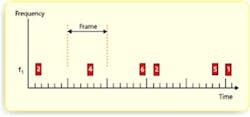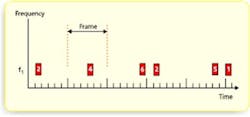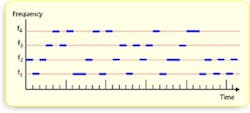Unity in Diversity Among 3G Mobile Phone Standards
Now that the overall character of the 3G mobile phone is taking form, we see distinct standards and technologies coming together to support specific services within different operating environments and unprecedented control over QOS.1 Since no single radio technique or family of technologies can fulfill the rich variety of services in 3G telephony, a single standard never will appear. Instead, a carefully coordinated collection of technologies is bringing unity in diversity.
The new technologies call on adaptive and efficient radio-access techniques capable of supporting speech, data services, access to the Internet, and mobile multimedia in both circuit- and packet-oriented forms. For example, an air interface capable of symmetric and asymmetric 2-Mb/s services in an office will not likely be very efficient in provisioning traditional circuit switched speech services to a commuter in a train. The air interfaces also must protect the deployed investment in 2G systems by providing backward compatibility.
Together, the collection of standards meets the requirements for IMT-2000 in the year 2000 which currently are being standardized and harmonized for worldwide 3G. Key among the strategies under consideration is GSM’s large, international footprint.
The wireless industry has matured to the point where the inherent advantages of CDMA techniques finally are understood and accepted. But even as CDMA dominates the standards, TDMA persists and grows to assume key roles in 3G.
Agreements like those between Ericsson and Qualcomm in 1999 are testaments to the importance of CDMA in 3G mobile-phone technologies, but pure TDMA technologies have grown to dominate important aspects, services, markets, and operating modes. Why does CDMA dominate but still allow TDMA to expand? Why are diverse radio interfaces the optimum for 3G? What are the testing consequences in a world of permanent uncertainty and diverse unity?
CDMA Overview
Today’s CDMA uses traditional DSSS radio techniques to organize DAMA in cellular systems. Two other forms of spread-spectrum radio include TH and FH.
TH CDMA, strictly referred to as TH-SS, transmits data in rapid bursts during unique time intervals assigned to each user. The time axis is divided into frames, and the frames are divided into time slots. A user will transmit in only one time slot during any frame.
Figure 1 illustrates the concept with a simple system in which there are only six time slots in each frame. The time-slot schedules are unique to each user. All spread-spectrum systems demand that receivers be synchronized to their corresponding transmitters, and the receivers know the spreading code of the transmitter.
Figure 1
Among the different spread-spectrum radio techniques, TH-SS is relatively simple to use, particularly when compared to FH-SS. TH-SS systems use transmitter power efficiently since all the user’s data is transmitted in short bursts at high power.
TH-SS has a relatively narrow spectrum requirement since all the transmitters operate on the same frequency. The near-far problem can be countered in TH-SS systems by scheduling transmissions among terminals so that they do not overlap.
The near-far problem refers to the tendency for terminals placed close to a cell-site receiver to overwhelm transmissions from more distant terminals. TH-SS is not widely used because synchronization must be maintained within a small fraction of a burst’s cycle. Acquiring synchronization can take up precious time better allotted to payload data. Also, the near-far problem is difficult to avoid when there are only a few spreading codes (transmission schedules) from which to choose.
A more widely used form of spread spectrum radio is FH-SS, sometimes called FH-CDMA. There are two forms: SFH and FFH.
Figure 2 illustrates the concept. Here we see a carrier can appear on one of four different frequencies with each time slot allotted for transmissions. The spreading code is the “dance” the FH-CDMA transmitter performs in the frequency domain, which is unique to each terminal. The SFH technique puts multiple symbols into each transmission, while FFH systems force the transmitter to hop around among its allowed transmission frequencies many times during each underlying information symbol.
Figure 2
The GSM system routinely uses SFH. When placed into the FH mode, GSM terminals change frequency with each burst or time slot. The large possible bandwidth of FH systems makes them the most effective CDMA systems, particularly in the case of FFH. But FFH demands a sophisticated frequency synthesizer or a bank of multiple synthesizers.
DSSS is a compromise technique. It is not as demanding on the radio equipment as FFH and shares the relatively narrow spectrum requirements of TH. Synchronization is more difficult with the DSSS technique than with the FH systems, but DSSS is a better solution against multipath distortion.
DS-CDMA separates users with unique high-speed spreading codes, sometimes called chipping codes, applied as secondary modulation. The codes are known to all the receivers, which are synchronized to the transmissions they are required to decode.
CDMA is an interference-limited system, which means that subscriber terminals are seen as sundry sources of interference to the base-station receiver. This puts a soft limit on the capacity of these kinds of systems and allows interference and noise management tools to help optimize CDMA networks.
TDMA interfaces, on the other hand, are limited by deterministic considerations. Once a radio sector has allotted all of its carrier frequencies and time slots to subscribers, new traffic is completely excluded. There is no such hard limit to the traffic that can be accommodated in CDMA systems.
The cdma2000 system, a 3G standard that protects all the IS-95 investments, increases the user data rate by allowing multiple parallel radio resources as shown in Figure 3 (see figure in April 2000 issue). A multicar-rier scheme that is easily compatible with IS-95’s 1.2288-MHz channels is one way to increase the capacity of the radio link. An alternative scheme calls for assigning multiple spreading codes in a single wideband signal.
Growth of TDMA in 3G
North America is the only region in which different 2G mobile radio systems have been used in the IMT-2000 frequency spectrum. Each of the 2G standards has different requirements for backward compatibility, and all of them appear on different core networks: ANSI-41 and GSM MAP. The ANSI-41 core network supports the AMPS, IS-136, and IS-95 air-interface systems, and the GSM MAP core network supports the GSM air-interface systems.
Many of the established U.S. operators are confined to 2 times 5-MHz licenses, which restrict their freedom in deploying WCDMA technologies. Greenfield operators have more options, but they cannot ignore the roaming freedom and cost savings of the AMPS and TDMA 2G systems.
AMPS/TDMA is to the Americas what GSM is to Europe: Both systems are too large, work too well, and have footprints too big to ignore. As a result, the TDMA and GSM communities are writing standards that will bring the two air interfaces together in two phases. The first is the GAIT initiative that converges the voice services of both systems.
The second phase allows sharing GPRS and EDGE. The 384-kb/s limit of the EDGE is seen particularly by spectrum-constrained North American operators as more than adequate for mobile multimedia application.
The EDGE Compact technique proposed by the UWCC is a synchronization technique that overlays time groups onto a frequency reuse pattern and specifies silent periods in the time groups. This allows sophisticated EDGE-based, multimedia services in frequency bands of less than 1 MHz.
If CDMA techniques were the only alternative for 3G services, many operators and whole markets would be excluded. User rates approaching 2 Mb/s, since they primarily will be low mobility services, are reserved for wideband protocols unique to the 3G versions of GSM and TDMA. The GSM extension is a WCDMA technique, which is part of the UMTS UTRA. The TDMA extension is called UWC-136HS, which uses pure TDMA and adaptive modulation to support 2-Mb/s service in a channel only 1.6 MHz wide.
Testing Considerations
3G systems bring two new testing paradigms to the market:
-
Autonomous network-based testing.
-
Fast prototype, content-based testing of new handsets and appliances.
2G systems already use embedded test techniques that regulate optimum network performance. IS-95 networks use FER reports from mobiles and the frequency of those reports as aids to interference management. IS-136 networks muster their mobiles into network optimization duties with MACA procedures, which let mobiles report their views of the RF environments to the network.
The network uses the reports to adaptively assign RF channels. IS-136’s HCS directs mobiles onto different types of cells depending on the network type (public, private, or residential), and its IDBR scheme adds an economic plane to the cell reselection criteria (home, partner, favored, neutral, and forbidden networks). 3G networks will expand these techniques so a mobile’s performance can be monitored by the network itself and use sophisticated measurement procedures in active mobiles to help manage network performance.
The test-equipment industry will have to move away from present-day parametric testing techniques of the wireless infrastructure toward less intrusive methods that test the capability of the network to heal and optimize itself.
3G wireless is all about introducing services frequently enough and with enough variety to keep today’s growth rates intact.
This forces operators and their partners into the content business, which implies a constant stream of new, specialized handsets and information appliances and more proprietary services with which operators can distinguish themselves from each other to prevent churn. 3G provides tools for a universe of new services and content.
Test-equipment suppliers will have to supplement their traditional instruments with highly specialized, proprietary solutions that can be shipped to a customer very quickly. The solutions in deployed systems must include innovative mechanisms to accommodate temporary and adaptable content testing scenarios at, and above, the Transport Layer (Layer 4).
Conclusion
3G cellular is an example of the development of interconnected innovations that integrate different radio techniques, network architectures, and legacy standards into a new system. These will likely be seen by subscribers and referred to by pundits as a completely new technology.
Our experiences with 3G will give us the means to design a single wireless standard. The market is neither ready for nor requires a single standard. The complementary inventions in 3G wireless telecommunications will demand alliances and standards, which, to the extent they are successful, will foster the fourth generation of services and technologies.
Reference
-
Lecklider, T., “Unity Eludes 3G Mobile Phone Standards,” EE-Evaluation Engineering, April 1999, pp. 40-48.
NOTE: This article can be accessed on EE Online. Select EE Archives and use the key word search.
|
Glossary of Terms AMPS advanced mobile phone service |
About the Author
Malcolm Oliphant is the strategic marketing manager for IFR and represents the company on several industry and standards committees. Formerly with Schlumberger Technologies, he has been involved with first- and second-generation cellular and private mobile radio systems for many years. Mr. Oliphant received a B.A. from Hawaii Loa College and has co-authored two books. IFR, 10200 W. York St., Wichita, KS 67215-8999, (316) 522-4981, e-mail: [email protected].
Return to EE Home Page
Published by EE-Evaluation Engineering
All contents © 2000 Nelson Publishing Inc.
No reprint, distribution, or reuse in any medium is permitted
without the express written consent of the publisher.
April 2000


